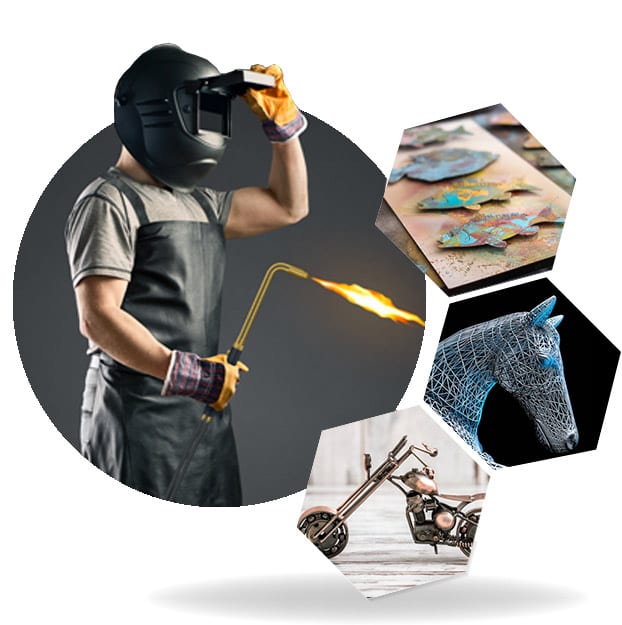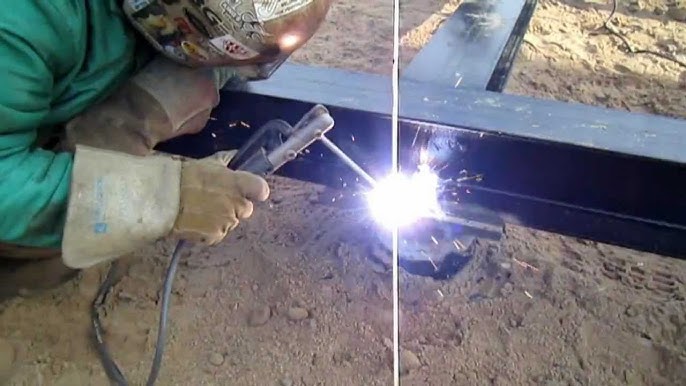Field guide for weld distortion by Belgrade Fabrication
Wiki Article
Common Welding Repair Service Issues and Exactly How to Address Them Properly
Welding repair services usually encounter a variety of problems that can endanger the honesty of the end product. Typical problems consist of insufficient infiltration, porosity, and misalignment, among others. Each defect offers distinct challenges that need details approaches for resolution. Recognizing these issues is necessary for welders intending to improve their end results and abilities. This conversation will certainly check out these common welding repair work concerns and reliable methods to address them.Inadequate Infiltration
Insufficient infiltration happens when the weld steel falls short to fully fuse with the base product, leading to weak joints and possible structural failures. This issue frequently stems from not enough heat input, inaccurate electrode angle, or incorrect welding speed. Welders might experience poor penetration as a result of a mistake of the necessary parameters for a specific product thickness or kind. Furthermore, contamination on the base material's surface can prevent reliable bonding, exacerbating the issue. To resolve inadequate penetration, welders ought to guarantee ideal setups on their equipment and maintain a tidy work surface. Routine evaluation of welds is advised to determine any type of shortages early, allowing for prompt improvements and the prevention of compromised architectural integrity in bonded assemblies.Porosity
Porosity is a typical flaw in welded joints that materializes as tiny gas bubbles trapped within the weld steel. This issue can jeopardize the stability of the weld, leading to lowered stamina and potential failing under anxiety. Fabrication. Porosity commonly develops from contamination, dampness, or inappropriate welding techniques, which allow gases to get away into the molten weld swimming pool. To resolve porosity, welders should guarantee appropriate surface area preparation, preserve a clean workplace, and make use of ideal welding specifications. Additionally, choosing the ideal filler product and protecting gas can reduce gas entrapment. Regular inspection and testing of welds can assist determine porosity early, assuring prompt corrective actions are taken, thereby protecting the high quality and reliability of the bonded structureMisalignment
Misalignment in welding can emerge from numerous variables, including incorrect setup and thermal development. Comprehending the origin is necessary for reliable resolution. Several improvement techniques are available to realign components and guarantee architectural stability.Reasons of Imbalance
Welding imbalance often originates from a selection of underlying concerns that can endanger structural honesty. One main reason is inappropriate fit-up of elements before welding, which can lead to voids and uneven surfaces. Variations in thermal development during the welding process can additionally result in distortion, especially if the products being signed up with have various coefficients of development. Furthermore, poor clamping and fixturing might stop working to hold elements securely in place, resulting in motion throughout welding. Poorly maintained equipment, consisting of welding machines and devices, may present disparities in the weld grain, additional contributing to imbalance. Finally, operator error, originating from not enough training or experience, can likewise play a considerable function in developing misaligned welds.Improvement Methods Readily Available
Resolving misalignment effectively needs a mix of corrective techniques tailored to the specific issues at hand. One common method is using jigs or fixtures to hold elements in the correct setting throughout welding, making sure constant alignment. Additionally, pre-heating the products can help in reducing distortion and improve fit-up. For significant imbalance, mechanical realignment methods, such as utilizing hydraulic jacks or clamps, can be utilized to correct the placement before welding. Post-weld warm therapy might also be needed to ease stress and anxieties created by imbalance. Finally, mindful examination and adjustment during the configuration phase can prevent imbalance problems from ending up being considerable issues, promoting a smoother welding process and boosting total structural stability.Distortion
Distortion is a typical difficulty in welding that can arise from numerous factors, including irregular cooling and heating. Recognizing the root causes of distortion is important for applying effective avoidance strategies. Resolving this concern not just enhances architectural integrity but likewise improves the total quality of the weld.Root causes of Distortion
When subjected to the intense warmth of welding, materials typically go through adjustments that can bring about distortion. This phenomenon mostly develops from thermal expansion and tightening during the welding procedure. As the weld area warms up, the material expands; upon air conditioning, it contracts, which can produce internal stress and anxieties. In addition, irregular home heating throughout a workpiece can worsen these stresses, smart welds causing bending or bending. The kind of material likewise plays a significant duty; steels with varying thermal conductivity and coefficients of development might react in different ways, resulting in unpredictable distortions. Inadequate joint design and poor fixturing can add to misalignment during welding, enhancing the chance of distortion. Recognizing these causes is crucial for reliable welding fixing and prevention methods.Prevention Techniques
Reliable avoidance techniques for distortion throughout welding concentrate on controlling warm input and ensuring correct joint style. Maintaining a constant warm input helps to decrease thermal development and contraction, which can lead to distortion. Making use of strategies such as pre-heating the work surface can likewise decrease the temperature slope, advertising uniform home heating. Furthermore, choosing appropriate joint styles, such as T-joints or lap joints, can boost stability and reduce stress focus. Implementing correct fixturing to secure the workpieces in position even more help in maintaining placement throughout the welding process. Ultimately, staggered welding series can distribute warm more uniformly, preventing local distortion. By using these methods, welders can significantly lower the chance of distortion and boost the overall high quality of their welds.Fracturing
Fracturing is an usual problem come across in welding fixings, frequently resulting from different elements such as inappropriate cooling rates, material option, or poor joint prep work. The incident this post of cracks can greatly endanger the stability of the weld, leading to potential failures during procedure. To resolve this issue, welders should initially assess the origin, ensuring that products are compatible and suitably picked for the specific application. Furthermore, controlling the air conditioning rate throughout the welding process is necessary; rapid air conditioning can induce stress and result in breaking. Correct joint style and preparation also contribute to reducing the risk. Applying these methods can improve weld high quality and sturdiness, ultimately reducing the probability of fracturing in ended up weldments.
Insufficient Blend
A substantial problem in welding repair work is incomplete fusion, which happens when the weld metal does not sufficiently bond with the base product or previous weld passes - Montana Mobile Welding and Repair. This defect can lead to weaknesses in the joint, possibly endangering the honesty of the bonded framework. Elements adding to insufficient fusion include not enough warm input, inappropriate welding technique, and contamination of the surface areas being joined. To resolve this issue effectively, welders ought to assure correct pre-weld the original source cleansing and surface prep work, as well as change their welding criteria to accomplish appropriate penetration and fusion. Regular examination throughout the welding procedure can additionally assist determine incomplete combination early, allowing for prompt restorative actions to improve the overall quality of the weldOverheating
While welding repair work can boost structural integrity, overheating presents a substantial challenge that can cause product destruction. Excessive warmth during welding can alter the mechanical residential or commercial properties of metals, leading to lowered strength, boosted brittleness, and bending. This sensation is specifically critical in high-stress applications where structural integrity is paramount. Determining overheating can entail aesthetic inspections for discoloration or distortion, in addition to checking temperature level during the welding procedure. To alleviate the dangers related to getting too hot, welders must use appropriate strategies, such as managing warm input, adjusting travel rate, and utilizing suitable filler products. Additionally, carrying out pre- and post-weld warm therapies can assist bring back material properties and enhance the total top quality of the fixing, ensuring lasting performance and safety and security.Regularly Asked Concerns
What Are the Usual Indications of a Welding Issue?

How Can I Test My Welds for Quality?
To check welds for quality, one can use aesthetic inspections, ultrasonic screening, and radiographic approaches. Each method guarantees structural stability, determines problems, and confirms adherence to defined standards, ultimately boosting the reliability of the bonded joints.What Security Precautions Should I Take While Welding?
When welding, one need to prioritize safety and security by using suitable individual safety tools, making sure appropriate air flow, protecting flammable products away, maintaining a tidy office, and being conscious of surroundings to avoid crashes and injuries.Can I Fix a Weld Without Redoing the Entire Joint?
Fixing a weld without remodeling the whole joint is feasible, relying on the damages (Montana Mobile Welding and Repair Welding). Techniques such as grinding, including filler product, or making use of a welding process can successfully attend to details flaws while preserving the surrounding structureWhat Tools Are Essential for Efficient Welding Services?
Vital tools for efficient welding repairs consist of a welding machine, wire brush, mill, safety gear, clamps, and filler materials. Each tool plays an essential function in making certain quality and safety throughout the repair service process. Porosity commonly emerges from contamination, dampness, or incorrect welding techniques, which permit gases to get away right into the liquified weld swimming pool. Inadequately kept tools, including welding equipments and tools, might introduce inconsistencies in the weld grain, additional contributing to misalignment. When subjected to the intense warm of welding, materials typically undergo modifications that can lead to distortion. Breaking is a typical problem experienced in welding repairs, often resulting from various aspects such as inappropriate cooling prices, product selection, or poor joint prep work. A substantial concern in welding repair services is insufficient blend, which happens when the weld metal does not appropriately bond with the base material or previous weld passes.Report this wiki page